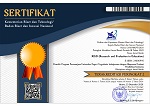Developing assessment instruments for the sensory acceptability of food products
Djemari Mardapi, Faculty of Engineering, Universitas Negeri Yogyakarta, Indonesia
I Gusti Putu Suryadarma, Faculty of Mathematics and Natural Sciences, Universitas Negeri Yogyakarta, Indonesia
Abstract
Keywords
Full Text:
PDFReferences
Azwar, S. (2000). Sikap manusia: Teori dan pengukurannya (2nd ed.). Yogyakarta: Pustaka Pelajar.
Bartko, J. J. (1976). On various intraclass correlation reliability coefficients. Psychological Bulletin, 83(5), 762–765. https://doi.org/10.1037/0033-2909.83.5.762
Borg, W. R., & Gall, M. D. (1989). Educational research: An introduction (5th ed.). New York, NY: Longman.
Brennan, R. L. (2006). Educational measurement (4th ed.). Westport, CT: Praeger.
Cizek, G. J., & Bunch, M. B. (2007). Standard setting: A guide to establishing and evaluating performance standards on tests. Thousand Oaks, CA: Sage Publications.
Mardapi, D. (2008). Teknik penyusunan instrumen tes dan nontes. Yogyakarta: Mitra Cendekia.
Mason, R. L., & Nottingham, S. M. (2002). Sensory evaluation manual. Phitsanulok, Thailand: Naresuan University.
Murti, B. (2011). Validitas dan reliabilitas pengukuran. In Matrikulasi Program Studi Doktoral. Surakarta: Fakultas Kedokteran, Universitas Sebelas Maret.
Rakhmat, J. (2007). Psikologi komunikasi. Bandung: Remaja Rosdakarya.
Shumate, S. R., Surles, J., Johnson, R. L., & Penny, J. (2007). The effects of the number of scale points and non-normality on the generalizability coefficient: A Monte Carlo study. Applied Measurement in Education, 20(4), 357–376. https://doi.org/10.1080/08957340701429645
Stone, H., & Sidel, J. L. (2004). Sensory evaluation practices (3rd ed.). Waltham, MA: Academic Press. https://doi.org/10.1016/B978-012672690-9/50013-5
Walgito, B. (1989). Pengantar psikologi umum (Rev. ed.). Yogyakarta: Andi Offset.
Watts, B. M., Ylimaki, G. L., Jeffery, L. E., & Elias, L. G. (1989). Basic sensory methods for food evaluation. Ottawa, Ontario: International Development Research Centre.DOI: https://doi.org/10.21831/reid.v3i1.13940
Refbacks
- There are currently no refbacks.

This work is licensed under a Creative Commons Attribution-ShareAlike 4.0 International License.








.png)







